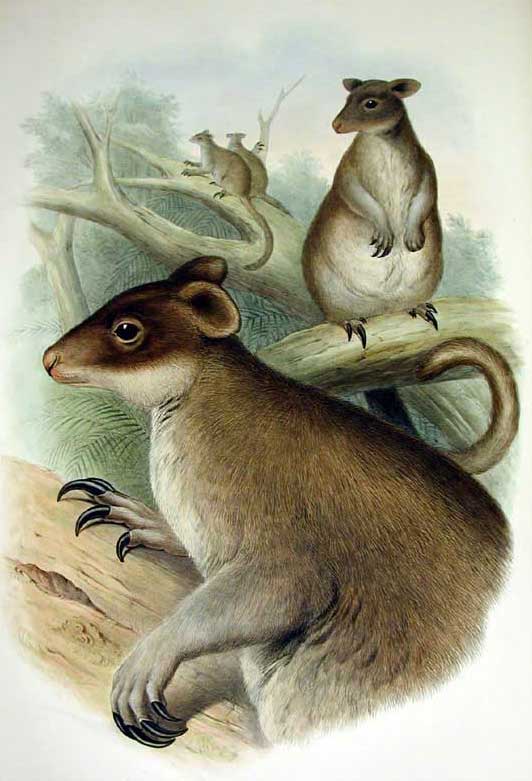
Dendrolagus inustus
Superregnum: Eukaryota
Cladus: Unikonta
Cladus: Opisthokonta
Cladus: Holozoa
Regnum: Animalia
Subregnum: Eumetazoa
Cladus: Bilateria
Cladus: Nephrozoa
Superphylum: Deuterostomia
Phylum: Chordata
Subphylum: Vertebrata
Infraphylum: Gnathostomata
Megaclassis: Osteichthyes
Cladus: Sarcopterygii
Cladus: Rhipidistia
Cladus: Tetrapodomorpha
Cladus: Eotetrapodiformes
Cladus: Elpistostegalia
Superclassis: Tetrapoda
Cladus: Reptiliomorpha
Cladus: Amniota
Cladus: Synapsida
Cladus: Eupelycosauria
Cladus: Sphenacodontia
Cladus: Sphenacodontoidea
Cladus: Therapsida
Cladus: Theriodontia
Subordo: Cynodontia
Infraordo: Eucynodontia
Cladus: Probainognathia
Cladus: Prozostrodontia
Cladus: Mammaliaformes
Classis: Mammalia
Subclassis: Trechnotheria
Infraclassis: Zatheria
Supercohors: Theria
Cohort: Metatheria
Cohors: Marsupialia
Cladus: Australidelphia
Cladus: Eomarsupialia
Ordo: Diprotodontia
Subordo: Macropodiformes
Familia: Macropodidae
Subfamilia: Macropodinae
Genus: Dendrolagus
Species: Dendrolagus inustus
Subspecies: D. i. finschi – D. i. inustus
Name
Dendrolagus inustus Müller, 1840
Type locality: Indonesia, Irian Jaya, Fakfak Div. Lobo Dist., near Triton Bay, Mt. Lamantsjieri
References
Dendrolagus inustus in Mammal Species of the World.
Wilson, Don E. & Reeder, DeeAnn M. (Editors) 2005. Mammal Species of the World – A Taxonomic and Geographic Reference. Third edition. ISBN 0-8018-8221-4.
Temminck: Verh. Nat. Gesch. Nederland Overz. Bezitt., Land- en Volkenkunde, p. 20, footnote [1840]
Wilson, D.E. & Reeder, D.M. (eds.) 2005. Mammal Species of the World: a taxonomic and geographic reference. 3rd edition. The Johns Hopkins University Press: Baltimore. 2 volumes. 2142 pp. ISBN 978-0-8018-8221-0. Reference page.
Vernacular names
magyar: Szürke kúszókenguru
日本語: ゴマシオキノボリカンガルー
The grizzled tree-kangaroo (Dendrolagus inustus) is a furry, long-tailed, bear-like mammal native to tropical rainforests on the island of New Guinea (split between Indonesia and Papua New Guinea). Like most tree-kangaroos (genus Dendrolagus), it lives in trees and eats leaves, fruit, and bark. It is a member of the macropod family Macropodidae with kangaroos, and carries its young in a pouch like other marsupials. The tree-kangaroo is uncommon and threatened by hunting and habitat loss. It is found in foothill forests of northern and western New Guinea and is indigenous to some of the offshore islands.[4]
Description
The grizzled tree-kangaroo grows to a length of about 75 to 90 cm (30 to 35 in) with males being considerably larger than females. It resembles a terrestrial kangaroo and its weight varies between about 8 and 15 kg (18 and 33 lb). The head is small, with a flat muzzle, the arms are powerful for climbing, the hind legs are long and the feet are large for an arboreal animal. The toes are armed with strong claws and the fourth toe is usually longer than the others. The otherwise bushy, cylindrical tail is often hairless at the base, and is used as a prop when climbing. Its colouring is between charcoal grey and chocolate brown with paler underparts. The ears are black and the toes and tail are dark.[5]
Distribution and habitat
The grizzled tree-kangaroo is native to tropical, foothill rainforests of northern and western New Guinea and some offshore island.[4] It can be found at elevations up to 1,400 m (4,600 ft) above sea level. Its range includes the Foja Mountains and the Bird's Head Peninsula and it occurs on the offshore islands of Yapen, Waigeo, Misool and Salawati, and possibly Batanta. It is present in both primary and secondary forests.[2]
Biology
The grizzled tree-kangaroo sometimes descends to the ground but spends most of its time in the forest canopy, as it is able to leap agilely from tree to tree.[5] It sleeps on a horizontal branch and feeds on the leaves, fruits and bark of trees.[5] The diet includes the leaves of Schuurmansiella angustifolia, Gnetum, Tetracera, Elatostema and arums and the leaves and fruit of fig trees.[6] The reproduction of this tree kangaroo has been little studied but breeding seems to take place once a year with a single young remaining in the female's pouch for about nine months.[5] Females with young have been observed in March, June and December and a single set of twins has been recorded.[6]
Status
The IUCN lists the grizzled tree-kangaroo as "vulnerable". It is an uncommon animal and its population is believed to be declining though its range and numbers have not been well studied. It is hunted for food and for the pet trade by the indigenous people and its habitat is being lost as forest is cleared for small-scale agriculture and to make way for plantations of oil palm. The animals living in the northern coastal mountain range are particularly threatened, but there is a community initiative there focusing on conservation of tree kangaroos. The animal appears in Appendix II of CITES.[2][5]
References
Groves, C. P. (2005). "Order Diprotodontia". In Wilson, D. E.; Reeder, D. M (eds.). Mammal Species of the World: A Taxonomic and Geographic Reference (3rd ed.). Johns Hopkins University Press. p. 60. ISBN 978-0-8018-8221-0. OCLC 62265494.
Leary, T.; Seri, L.; Wright, D.; Hamilton, S.; Helgen, K.; Singadan, R.; Menzies, J.; Allison, A.; James, R.; Dickman, C.; Aplin, K.; Flannery, T.; Martin, R.; Salas, L. (2016). "Dendrolagus inustus". IUCN Red List of Threatened Species. 2016: e.T6431A21957669. doi:10.2305/IUCN.UK.2016-2.RLTS.T6431A21957669.en. Retrieved 11 November 2021.
"Appendices | CITES". cites.org. Retrieved 2022-01-14.
Flannery, T. 1995. Mammals of New Guinea. Reed Books. ISBN 0-7301-0411-7
Ho, Yan-Iuan (2004). "Dendrolagus inustus: grizzled tree kangaroo". Animal Diversity Web. University of Michigan. Retrieved 2014-07-10.
"Grizzled Tree-kangaroo Dendrolagus inustus Müller, 1840". Papuan Mammals. Archived from the original on 2014-07-14. Retrieved 2014-07-10.
Retrieved from "http://en.wikipedia.org/"
All text is available under the terms of the GNU Free Documentation License

